ITALY INVADES ETHIOPIA
Rome, Italy • October 3, 1935
On this date in 1935 Benito Mussolini’s Italy invaded the Northeast African Kingdom of Abyssinia (present-day Ethiopia) without a declaration of war, and for doing so the League of Nations (forerunner to today’s United Nations) instructed its member states to impose limited economic sanctions on Italy. (Neither the U.S. nor Germany were members of that international body.) The next year, after Italian forces had vanquished Emperor Haile Selassie’s feudal kingdom using modern European weaponry, including airplanes, tanks, heavy artillery, machine guns, and poison gas, Mussolini crowed to an audience in Rome’s Palazzo Venezia on May 9, 1936, the day Ethiopia was formally annexed, that “Italy has at last her Empire—a Fascist Empire.” Fascist East Africa consisted of Ethiopia, Eritrea, and Italian Somaliland, the latter 2 possessions acquired by various treaties in the 1880s. In the piazza below his palace balcony, Mussolini’s worshiping crowd roared their approval over and over again: “Duce, Duce, Duce!” (Leader, leader, leader).
Years earlier, in 1925, Mussolini (1883–1945) had stated: “I want to make Italy great, respected, and feared” throughout Europe and the rest of the world. His words brought to mind the past glory of the Roman Empire, with its imperial reach throughout the ancient Mediterranean basin (Mare Nostrum, Latin for “Our Sea”) and deep into Africa. But militarily overwhelming an ill-prepared and badly equipped African army was a long way from Mussolini’s vision of projecting Italian supremacy among her modern-day Mediterranean neighbors, and for that he needed a strong ally.
Adolf Hitler’s Nazi Germany was an easy mark. In 1936 Mussolini made his first reference to a “Rome-Berlin axis” in a speech in the northern Italian city of Milan, formalizing it in a treaty of friendship his nation signed with Germany on October 25 of that year. (The “Rome-Berlin axis,” in the sense used by Mussolini, envisioned a Europe wherein neighboring states revolved around a geopolitical pole connecting both Central European capitals.) The 2 dictators with their “ideological affinities”—a phrase used by both National Socialists and Italian Fascists in official and unofficial communications—had met for the first time in June 1934 in Venice, Italy. The October 1936 “Treaty of Friendship” recognized each country’s spheres of interest: Germany’s north of the Alps, where the nations of Austria, Czechoslovakia, and Poland lay, and Italy’s to the east and south: to Albania, Yugoslavia, Greece, Turkey, the Mediterranean islands of Malta and Cyprus, and North Africa. To commemorate the 1936 pact, Germany issued a postage stamp depicting the 2 dictators standing shoulder to shoulder, at the top of which was written: “Zwei Völker und Ein Kampf” (“Two Peoples and One Struggle”).
Il Duce: Wave Maker in Italy’s Mare Nostrum
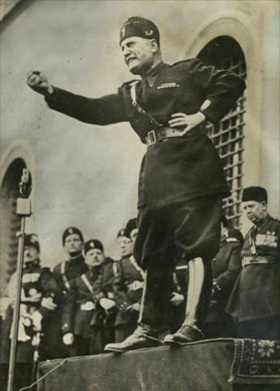 | 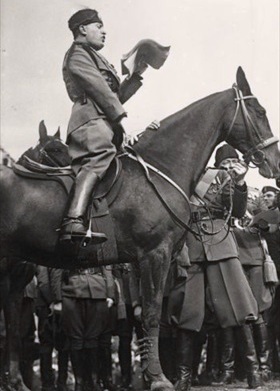 |
Left: Benito Mussolini at a National Fascist Party rally. During the 1920s and 1930s, Nazi Party leader Adolf Hitler frequently paid homage to Fascism and its supreme party leader Il Duce. Both dictators used the political parties they founded to seize and consolidate their power at the national level, Hitler more brutally than Mussolini. Mussolini ruled Italy constitutionally from 1922 to 1925, when he dropped all pretense of democracy and set up a one-party dictatorship that ruled the country until he was toppled from power by his own Fascist Party in July 1943 shortly after Anglo-American amphibious landings in Sicily (Operation Husky). Hitler, “der Fuehrer” (the leader) of Germany’s Nazi Party, was appointed chancellor (head of government) by German President Paul von Hindenburg in late January 1933 and solidified his dictatorship after Hindenburg’s death in August 1934.
![]()
Right: As the self-anointed heir to the Roman Caesar, Mussolini frequently used props, military uniforms, and settings that evoked power and prestige. In this photo from 1929 he is seen addressing an audience in Northern Italy mounted on horseback. On another occasion he addressed Italian troops from the top of a tank, arms akimbo.
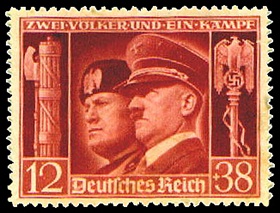 | 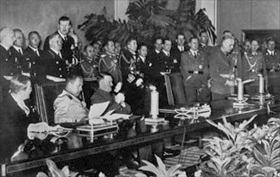 |
Left: Mussolini and Hitler appear on this German stamp commemorating the 1936 Italian-German Treaty of Friendship. Translation of text at the top: “Two Peoples and One Struggle.”
![]()
Right: The term “axis” was first used by Mussolini in November 1936 when he spoke of a Rome-Berlin axis arising out of the Italian-German Treaty of Friendship of October that year. Later, in May 1939, this relationship morphed into a military and economic alliance, which Mussolini referred to as the “Pact of Steel.” The term “Axis powers” formally came into being after the Tripartite Pact was signed by Italy, Germany, and Japan in a gala ceremony (shown here) on September 27, 1940, in Berlin, Germany. Membership in the pact expanded later that year and the next with the addition of Hungary, Romania, Slovakia, and Bulgaria. In its heyday (1941–1943) 9 nations were united in a pact whose value chiefly benefited Hitler’s propaganda machine.
Fox Movietone News: Italo-Ethiopian War, 1935
![]()

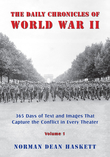 History buffs, there is good news! The Daily Chronicles of World War II is now available as an ebook for $4.99 on Amazon.com. Containing a year’s worth of dated entries from this website, the ebook brings the story of this tumultuous era to life in a compelling, authoritative, and succinct manner. Featuring inventive navigation aids, the ebook enables readers to instantly move forward or backward by month and date to different dated entries. Simple and elegant! Click
History buffs, there is good news! The Daily Chronicles of World War II is now available as an ebook for $4.99 on Amazon.com. Containing a year’s worth of dated entries from this website, the ebook brings the story of this tumultuous era to life in a compelling, authoritative, and succinct manner. Featuring inventive navigation aids, the ebook enables readers to instantly move forward or backward by month and date to different dated entries. Simple and elegant! Click 











